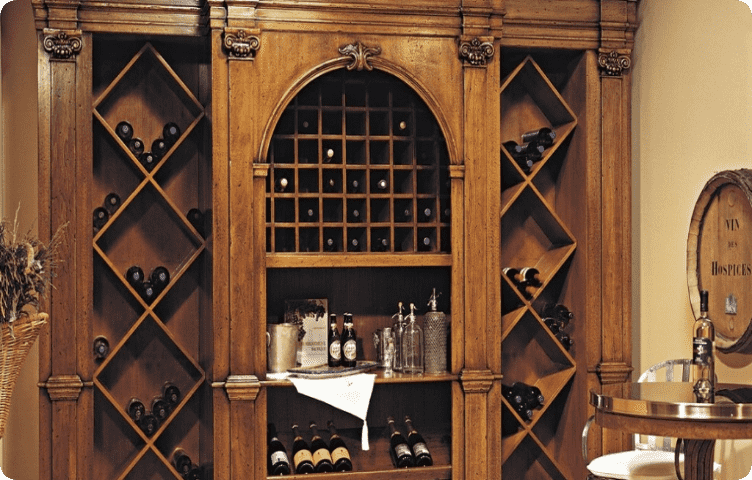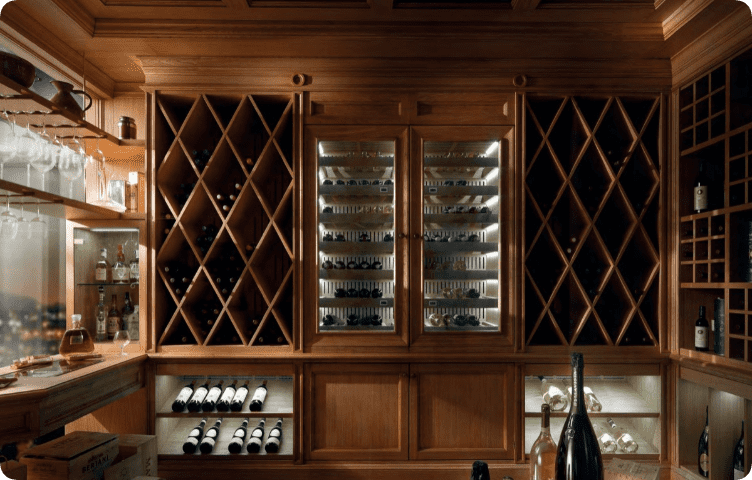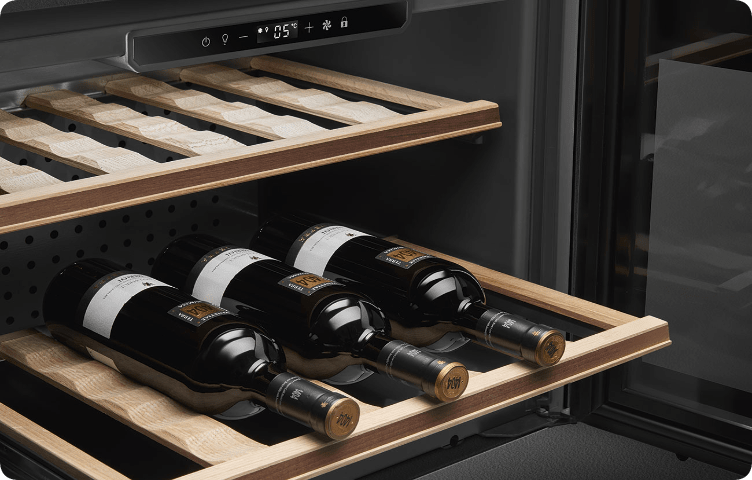Good wine retains its quality for several years if stored correctly. The ideal option is to keep the bottles in the cellar, and if you don’t have one, in the wine cabinet. This piece of furniture allows you to maintain temperature and humidity at the level required for different types of alcohol. Let's get acquainted with the features of an unusual storage space!
Why do you need a wine cabinet at home?
The wine retains its original taste and aroma at a temperature of + 10-15° C. The air humidity in the room where the product is kept should be at least 50%, ideally 60-80%. Bottles are stored away from light, in a horizontal position, without exposure to vibration.
It is impossible to comply with these requirements in an ordinary apartment. The temperature in the living room is much higher, especially in the kitchen. In the refrigerator, on the contrary, it is too cold for wine - no higher than +8° C. Horizontal shelves in the refrigerator are not enough for a large wine collection.
All problems are solved by having a wine cabinet - a piece of furniture with a special shelving system and a built-in cooling mechanism. It can be equipped with several independent temperature zones for storing different types of alcohol. The equipment is suitable for storing unopened and already opened bottles. Depending on the size, the product holds from 8 to 600 units of product.

Construction of wine cabinets
Externally, the equipment looks like ordinary furniture with a glazed or solid door. But inside there is a built-in cooling system powered by a compressor motor. Automatic ventilation directs air through special openings, maintaining the required level of humidity. The door and body of the product are sealed, like in a regular refrigerator. But there is no vibration harmful to wine here - it is damped using pallets with shock absorbers. The motor does not come into contact with the walls, which also prevents vibration.
The control panel allows you to turn the equipment on and off, and set the temperature for different zones. You can check the indicators using the digital display. There are models with a remote control.
Types of wine cabinets and their advantages
Stores offer many device options - built-in and free-standing, compressor and thermoelectric, wooden and metal. Externally, the product may resemble an antique buffet or a huge loft-style wine storage facility.
Regardless of the type and design, wine coolers provide many useful advantages:
- cool the alcohol to the required temperature;
- maintain the optimal temperature for drinks in an unheated room;
- automatically regulate humidity levels;
- promote the maturation of wines;
- protect the product from vibration and foreign odors;
- aesthetically decorate the room.
- Since the doors seal tightly, the risk of oxidation of the wine inside is minimized. Thanks to this, drinks in open bottles retain their taste and aroma throughout the week.

Design
There are two main types of products - bar and home. The first category is distinguished by its large capacity and durable body made of metal and polymer plastic. For ease of movement, the bottom of the furniture is equipped with wheels.
The doors of bar models are made of quartz glass, which does not let daylight in. The shelves are usually metal, on telescopic guides, so they are convenient to pull out for loading and unloading.
Home cabinets are close in design to ordinary furniture. The outer part of the case can be covered with wood; the shelves inside are also made of wood or other durable materials - metal, tempered glass. There are three shelf options:
- horizontal;
- vertical;
- reversible (double-sided).
Some models use 2-3 types of shelves simultaneously.
The door of a home wine cabinet can be transparent or solid. In the latter case, the door is equipped with a recorder that records the installation dates inside each bottle.
Principle of operation
There are two types of cooling mechanisms - compressor and thermoelectric. The first one works on the same principle as a regular refrigerator - using a compressor motor, it directs freon through metal tubes. The anti-vibration system protects the device from vibrations.
The thermoelectric mechanism transfers heat from one side of the body to the other using the direction of electric current. Since these models do not have a motor, there are also no vibrations. But thermoelectric cabinets depend on the surrounding thermal environment; they cannot be built into a niche or under a table.
Temperature
The cooling method depends on the purpose xwounding wine - create the correct temperature for serving or allow the drink to ripen. According to these tasks, two types of cabinets have been developed:
temperature - designed for normal storage of alcohol. Used to cool the product before serving;
climatic - create the conditions of a wine cellar in which young wines are kept until the ripening stage. Provide a temperature range from +10 to + 14° C.
Collectors store several types of alcohol at the same time in wine stores. Since red, white and sparkling wines require different temperatures, multi-temperature devices have been developed that have 2-4 compartments for different drinks. In each of them you can set a separate temperature mode.
There are also models with a freezer designed to quickly cool old wines and champagne.

How to use?
For proper operation, the wine cooler requires an appropriate room - well ventilated, with a humidity level of no more than 75%. The floor must be flat, covered with material that insulates electricity - wood, ceramic tiles, linoleum. The equipment can only be connected to an ungrounded socket with a voltage of 220 V, without extension cords.
The room temperature must be maintained at +20-25° C. Special models are produced for unheated rooms, but this function must be indicated in the instructions.
A newly purchased product should be wiped from the inside with a damp soft cloth. You can connect the equipment to the network only 2 hours after installation. Then the required mode is configured using the control panel. If the model does not provide temperature zones, the bottles are arranged according to the types of drinks - red wines on top, sparkling wines on the bottom.
The device must not be used to store food. This disrupts the internal microclimate and creates unpleasant odors.
Selection options
The first criterion by which you should evaluate a wine cooler is its purpose in your home. If you collect expensive alcohol, choose a large multi-temperature model. A mini-temperature cabinet is suitable for everyday wine storage.
Consider four more characteristics:
cooling mechanism - for spacious rooms it is better to purchase a thermoelectric system in the form of a separate piece of furniture. In a small apartment it is more practical to install a built-in compressor model;
spaciousness - in a bar or private house you can install a wine library with several dozen seats. In small-sized housing, a cabinet with 1-2 shelves that can hold 8-12 bottles is more appropriate;
material - wood-lined body and wooden shelves minimize vibration. Metal and tempered glass ensure a long service life of the equipment, which is beneficial for bars and restaurants;
design - the appearance of the product should be consistent in style with the decor of the room. If the wine cabinet is intended to be installed in a room where visitors rarely visit, choose a model with a solid door to protect the contents from light as much as possible.
Choosing a wine cabinet is not an easy task for those who are doing it for the first time in their life. To avoid mistakes, consider only products from highly rated brands - Smeg, Liebherr, Vestfrost, Teka.
Maintenance and care
The wine cooler does not need to be defrosted and washed like a regular refrigerator. If it is necessary to wipe the shelves from the inside, the equipment is disconnected from the network and unloaded. Wash the internal parts with a soft cloth and a non-aggressive detergent or an aqueous soda solution. The condenser must be vacuumed or brushed once a year.
It is not recommended to disconnect the device from the network in order to save energy. Frequent changes in temperature have a negative impact on the quality of wines, especially young ones that need ripening.
















































/https%3A%2F%2Fcomplexbar.com%2Fimages%2Fblog%2F244%2Fsomel_glavn.jpg)
/https%3A%2F%2Fcomplexbar.com%2Fimages%2Fblog%2F246%2Fsirop_scale_2400.jpeg)
/https%3A%2F%2Fcomplexbar.com%2Fimages%2Fblog%2F246%2Fkofe-vostochniy.jpg)
/https%3A%2F%2Fcomplexbar.com%2Fimages%2Fblog%2F245%2Fpexels-jason-villanueva-851555.jpg)
/https%3A%2F%2Fcomplexbar.com%2Fimages%2Fblog%2F246%2F2024-04-09_17.22.54.jpg)
/https%3A%2F%2Fcomplexbar.com%2Fimages%2Fblog%2F246%2F2024-04-09_17.22.47.jpg)
/https%3A%2F%2Fcomplexbar.com%2Fimages%2Fblog%2F246%2FCODE_anons_foamydrops_752%D1%85480_eng.jpg)
/https%3A%2F%2Fcomplexbar.com%2Fimages%2Fblog%2F246%2FAlina_752%D1%85480_eng.jpg)
/https%3A%2F%2Fcomplexbar.com%2Fimages%2Fblog%2F246%2F2024-04-09_17.23.22.jpg)
/https%3A%2F%2Fcomplexbar.com%2Fimages%2Fblog%2F246%2F2024-04-09_17.23.28.jpg)
/https%3A%2F%2Fcomplexbar.com%2Fimages%2Fblog%2F246%2F2024-04-09_17.23.35.jpg)
/https%3A%2F%2Fcomplexbar.com%2Fimages%2Fblog%2F246%2Fdrinksome_752%D1%85480_eng.jpg)
/https%3A%2F%2Fcomplexbar.com%2Fimages%2Fblog%2F246%2Fnude_752%D1%85480_eng.jpg)
/https%3A%2F%2Fcomplexbar.com%2Fimages%2Fblog%2F246%2F752%D1%85480_eng__1_.jpg)
/https%3A%2F%2Fcomplexbar.com%2Fimages%2Fblog%2F246%2F752%D1%85480_eng.jpg)
/https%3A%2F%2Fcomplexbar.com%2Fimages%2Fblog%2F246%2FStudioRaw_752%D1%85480_eng.jpg)
/https%3A%2F%2Fcomplexbar.com%2Fimages%2Fblog%2F246%2FDoppio_tea_752%D1%85480_eng.jpg)
/https%3A%2F%2Fcomplexbar.com%2Fimages%2Fblog%2F246%2FTognana_Stars_Stripes_752%D1%85480_eng.jpg)
/https%3A%2F%2Fcomplexbar.com%2Fimages%2Fblog%2F246%2FRona_752%D1%85480_eng.jpg)
/https%3A%2F%2Fcomplexbar.com%2Fimages%2Fblog%2F246%2FDoppio_vending_752%D1%85480_eng.jpg)
/https%3A%2F%2Fcomplexbar.com%2Fimages%2Fblog%2F246%2FEssence_sukhie_smesi_752%D1%85480_eng.jpg)
/https%3A%2F%2Fcomplexbar.com%2Fimages%2Fblog%2F246%2FODK_sukhie_smesi752%D1%85480_eng.jpg)
/https%3A%2F%2Fcomplexbar.com%2Fimages%2Fblog%2F246%2Funiforma-barmena.jpg)
/https%3A%2F%2Fcomplexbar.com%2Fimages%2Fblog%2F246%2Fkak-nanyat-barmena.jpg)
/https%3A%2F%2Fcomplexbar.com%2Fimages%2Fblog%2F246%2Fsirop_scale_2400.jpeg)
/https%3A%2F%2Fcomplexbar.com%2Fimages%2Fblog%2F246%2FPeugeot_Anons_Paris_U%27Select_Line_Daman_752%D1%85480_eng.jpg)
/https%3A%2F%2Fcomplexbar.com%2Fimages%2Fblog%2F246%2Fkofe-vostochniy.jpg)
/https%3A%2F%2Fcomplexbar.com%2Fimages%2Fblog%2F246%2FMadler.jpg)
/https%3A%2F%2Fcomplexbar.com%2Fimages%2Fblog%2F246%2Fprofbartender_glavn.jpeg)